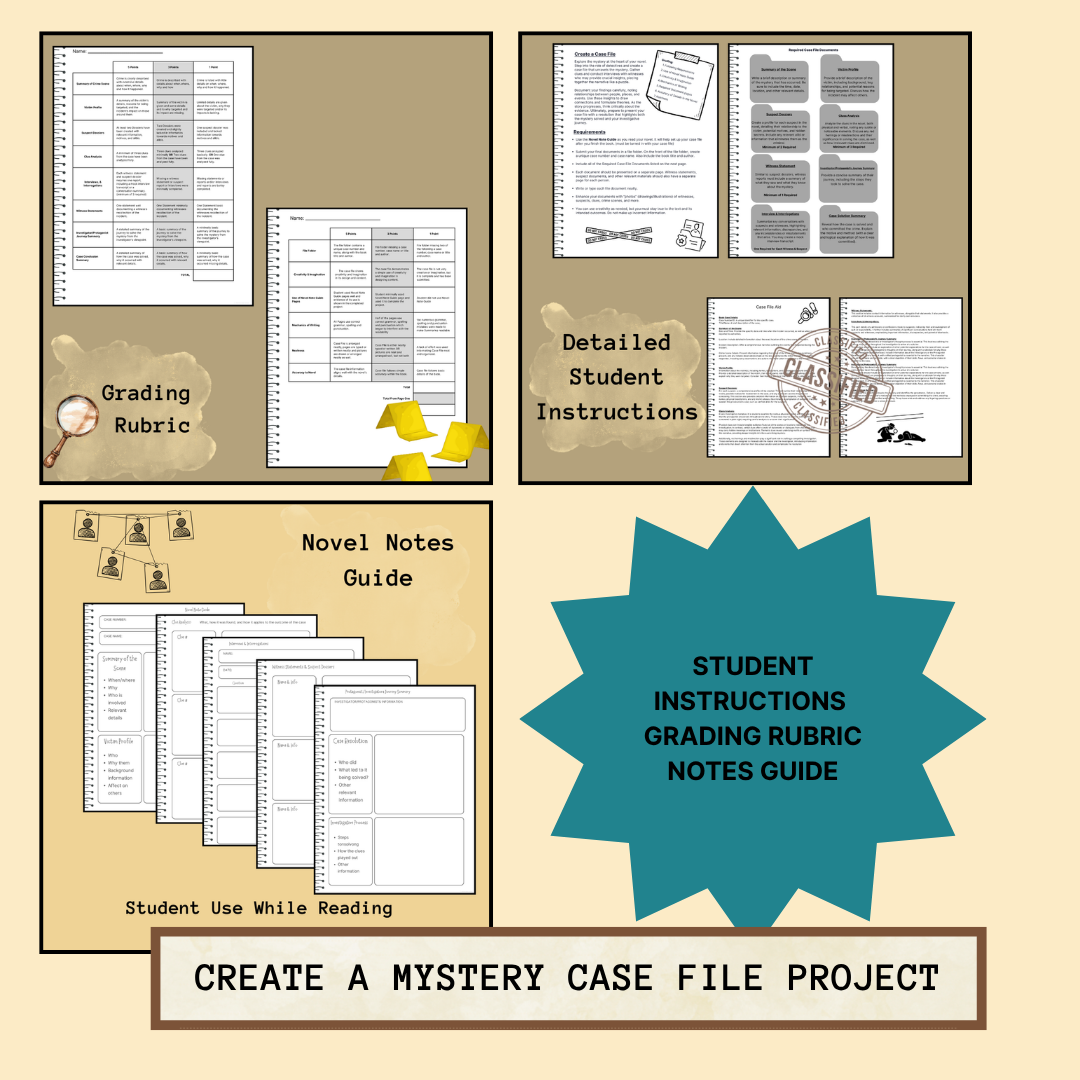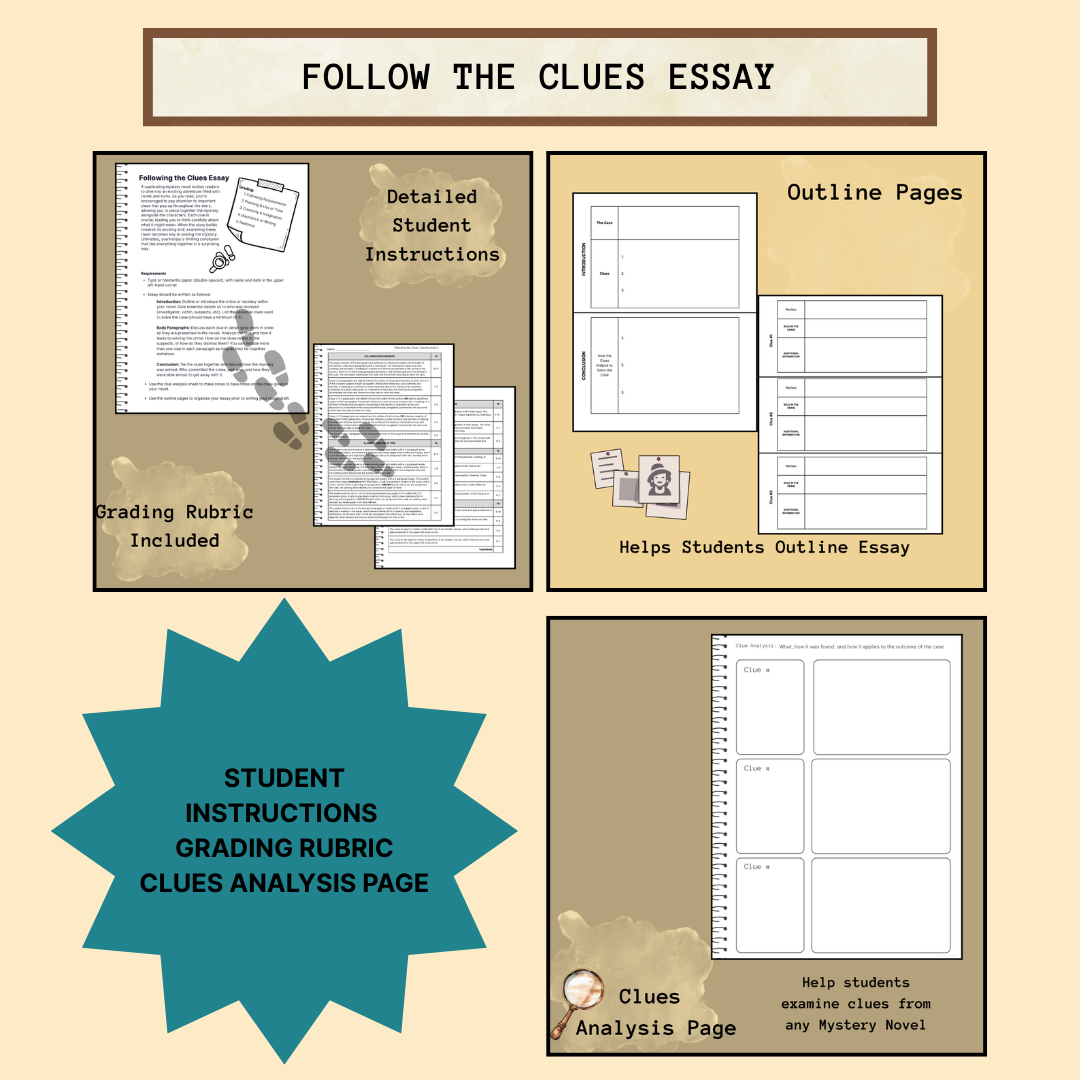Mystery Literature MEGA Bundle: Doodle Notes, Lessons & Activities, Essay, & Project
Mystery Literature MEGA Bundle: Doodle Notes, Lessons & Activities, Essay, & Project
Mystery Literature Mega Bundle- $19 Value
Mystery Doodle Notes $2.00
Engaging Students with Mystery Literature and encourage your students to take notes on mystery and fill them in as you explore various aspects of this genre together. You can utilize the answer key for grading their notes or distribute it if time doesn't allow for a whole-class lecture on the subject. Additionally, I offer supplementary teacher notes that provide extra explanations for the bullet points on the Doodle Notes page, giving students further insights to bolster their understanding.
Also Included:
Genre Checklist Worksheet: This worksheet helps students determine whether a text fits within the genre. They should be able to identify the mystery or crime and the investigator, and then provide one to two examples for the other elements to substantiate that the text belongs in the genre. This can be applied to any novel, picture book, short story, or film.
Any Mystery Novel Questions: These questions are tailored for any story or novel within mystery literature. An answer key is not provided, as responses will vary based on the specific novel being read. Students should record their answers on a separate piece of paper.
Recommended Reading List: This list features books I highly recommend for this genre. My kiddos and I have read most of the titles and verified their content for appropriateness; some we haven't, but I've chosen them based on reviews by others or because they're considered classics within the genre. The list is organized by Lexile number and recommended grade levels.
9 Pages Total: 2 Student Note Pages, 2 Answer Key Pages, 2 Teacher Notes Pages, 1 Genre Check List Page, 1 Any Mystery Novel Question Page, and 1 Page Book Recommendation
Whodunit & Following the Clues Mystery Activities & Lessons ($5):
Students will learn what a whodunit mystery is in an introductory lesson. They will apply this knowledge to a Mini Whodunit activity, a comprehension worksheet, and a quiz. Students will also then use this knowledge with five Whodunit Mini Stories and answer the accompanying comprehension questions.
Included:
Whodunit Introduction Lesson
Mini Whodunit Scenario Activity: Case Outline, Victim & Crime Sheet, Suspect Pages, Clue Pages, and Detective Notebook Pages
Comprehension quiz/worksheet with answer key
Whodunit Mini Stories: 5 Short stories with comprehension worksheets and answer keys.
Follow the Clues Lesson Instructions, which include three options to complete and two worksheets to choose from.
(40 Pages Total: 15 Teacher Pages and 25 Student Pages)
The Inference Lessons and Activities package ($4) includes:
Inference Detective Lesson: Introduces inference using excerpts, picture books, or films with worksheets for examples, source text analysis, and paragraph creation.
Show Don't Tell Activity: Helps students learn how authors imply character traits through description, featuring two worksheets for guessing and creating character traits.
Inference Lesson with Mini Stories: Students read short paragraphs and answer inference questions, with four main and three bonus stories provided.
What's in the Bag Activity: Students infer a common theme from prepared bags of objects, using a worksheet to record their responses.
Create a Bag Activity: Students design bags with objects related to a known character or story, using a provided worksheet.
Social Media Inference Activity: Students analyze three fictional profiles and answer inference questions based on them.
(32 Pages Total: 14 Teacher Pages and 18 Student Pages)
Foreshadowing Lessons & Activities: $3
Introduction Lesson: Introduces students to direct and indirect foreshadowing.
Introduction Activity: Involves using excerpts from books or films for students to identify foreshadowing. Instructions for a Notes Worksheet are provided.
Notes Worksheet: Students record examples of foreshadowing, predict meanings, and analyze actual meanings.
Excerpt Example: A sample paragraph showcasing foreshadowing, with a chart for student analysis.
Short Stories Lesson: Students read the first half of a short story, use foreshadowing techniques to answer questions, then read the second half to assess their predictions. An answer key is included.
(22 Pages Total: 8 Teacher Pages and 14 Student Pages)
Follow the Clues Essay $2.00
Students will track the clues presented in their novel, helping them understand how these hints contribute to unraveling the mystery by the story's conclusion. They will examine how these clues integrate into the narrative and ultimately how they assisted the investigator or main character in solving the crime.
Included:
Student Requirements Page: This outlines the requirements for the Following the Clues Essay for students. Introducing the assignment with the grading expectations and suggestions for completion.
Clue Analysis Page: These pages enable students to jot down clues in preparation for the essay or project in a guided manner, ensuring they meet all the requirements for the assignment.
Outline Pages: Students will use these to help outline their essay, keeping their thoughts consistent and concise.
Grading Rubric: Based on the requirements listed on the student's page, this rubric is designed to facilitate easy grading of the essay or project. Assign grade values as desired.
7 Total Pages: 1 Student Requirements Page, 1 Clue Analysis Page, 2 Outline Pages, 2 Grading Rubrics, and 1 Instructional page.
Create Mystery Case File $3.00
Students will embark on a creative journey to develop a case file based on a mystery novel they've read. They will analyze the plot, explore character motivations, and connect clues to solve the mystery. This project will enhance their understanding of the narrative while fostering critical thinking and analytical skills in the captivating realm of mystery literature.
Included:
Student Requirement Pages: Outline the project for students on what is included and what is to be graded.
Case File Aid which helps students better understand the components of the case file.
Student Novel Guide Pages: students will use this as they read their novel to help outline the various aspects the must document in their case file.
Grading Rubric based on the requirements listed on the student's page, this rubric is designed to facilitate easy grading of the essay or project. Assign grade values as desired.
13 Total Pages: 2 Case File Aid, 2 Student Requirement Pages, 5 Student Novel Guide Pages, 3 Grading Rubric Pages, and 1 Instructional Page




